Hello, I thought it would be fun to tell you about my wedding day in Germany. I have been married since July 2013. It was a beautiful day and I wanted to take the opportunity to share this special memory with you.
This will be a rundown of my wedding day – but I will try to point out our particular German wedding customs and traditions to you. And of course, I will tell you about everything we ate.
This was not a traditional German wedding - as we are a German-British couple. I will point out the traditional German wedding elements to you but also the differences between ours and a traditional German wedding.
I had lots of fun organising my wedding, so if you are getting married soon, I hope this will give you some German wedding ideas and inspire you.
Background
When my husband proposed, two things were immediately clear to me. Firstly, that I wanted to spend the rest of my life with him and secondly that I wanted a German wedding. At the time, we were living in London and as my husband is English, this would mean flying half of the wedding party to Germany.

The Wedding Location
We flew over to Germany five times in total before our wedding.
We wanted the location to be close to my parents, who live near Frankfurt. I had a long list of venues that covered everything from a monastery, a barn to a wine cellar.
However, the first moment I stepped into a little German vineyard called “Klostermühle" in Eltville, I knew we had found the right spot.
Situated in the midst of the Rheingau, one of Germany’s largest wine-producing areas, the Klostermühle used to produce the wine for the nearby Kloster Eberhard.
The Wedding Ceremony.
It was important to me that we would have a traditional church wedding. However, in Germany the state and the church are two different entities. (This is different in the UK where the Queen is the head of state and head of the Church of England). This meant that we had to have two ceremonies, as a church ceremony alone is not legally binding in Germany.
We had a brief civil ceremony in London, at the Marylebone Registry office a month before, with only three people attending.
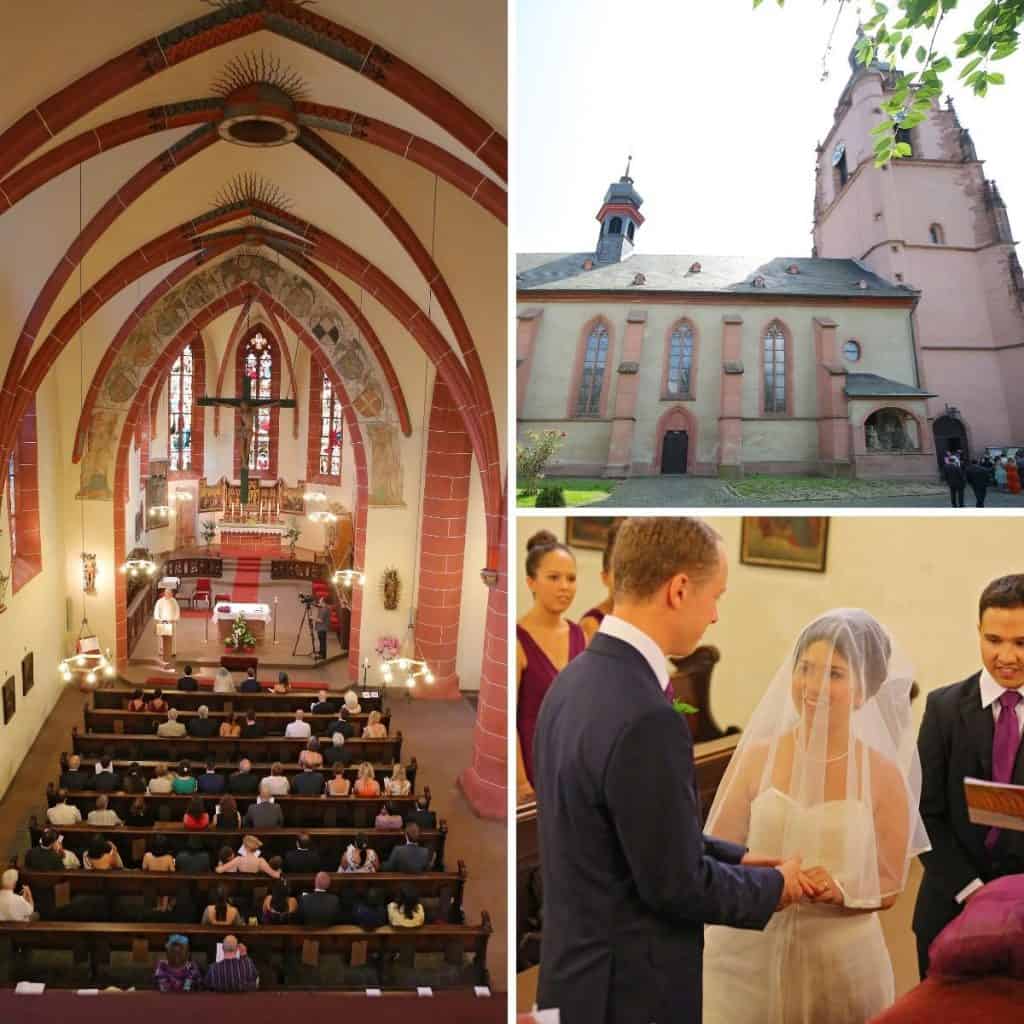
For our big German church wedding, we were lucky to have secured the St. Peter und Paul Church in Eltville. It is a Baroque church that was first established in the 10th century.
Our wedding ceremony was conducted in English and in German. I said my vows in German, and Dave did his in English.
Hochzeitsballons steigen lassen (to launch wedding balloons a German wedding tradition)
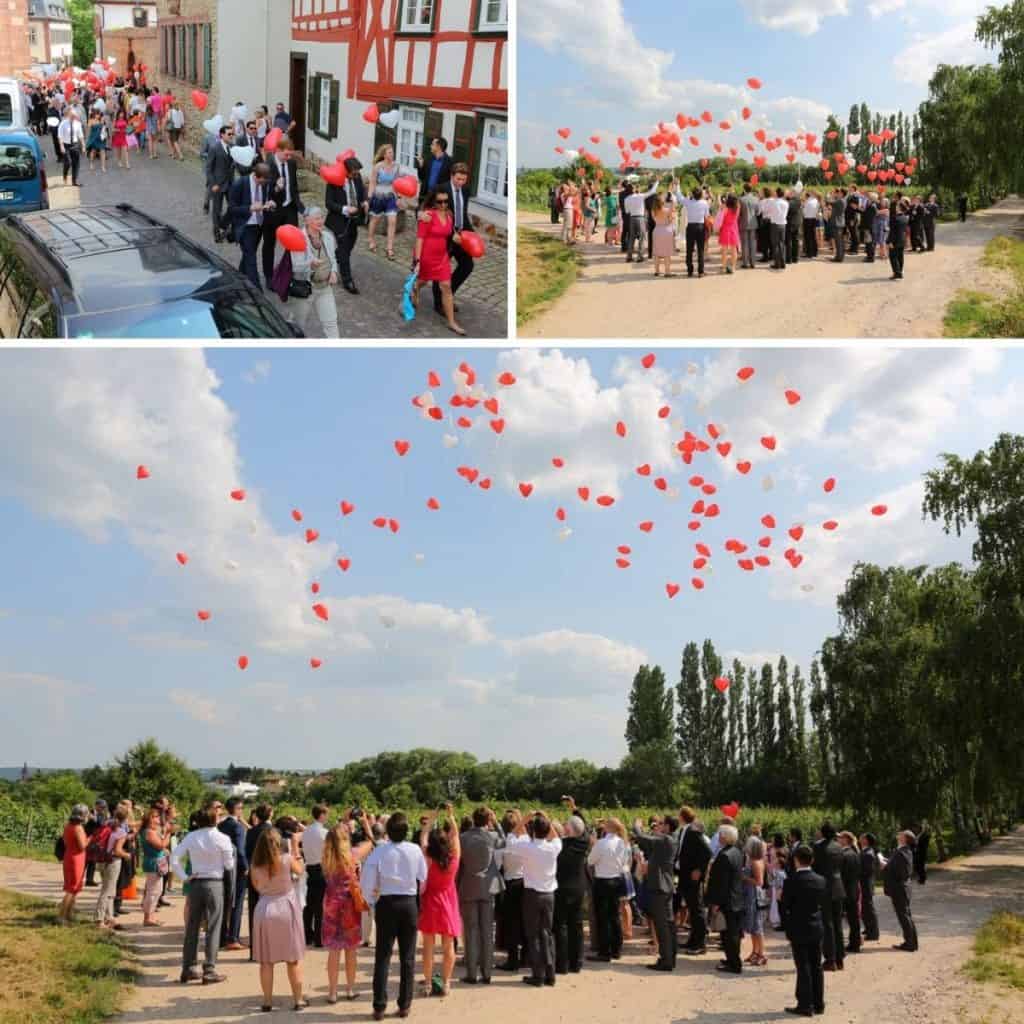
After the church ceremony, we took the obligatory group photo. We gave every guest a helium-filled heart-shaped balloon and they walked with it to our wedding location which was about 10 minutes away. There we let them rise into the air.
Now traditionally the helium-filled balloons have a postcard attached with the wedding couples address. The finder then can send it back to the couple and pass on their congratulations. This way the couple will be reminded of their special day, days or even weeks after their wedding.
(We did not follow this custom, as we did not think that people would return the cards abroad).
The German Wedding Cake (Hochzeitstorte)
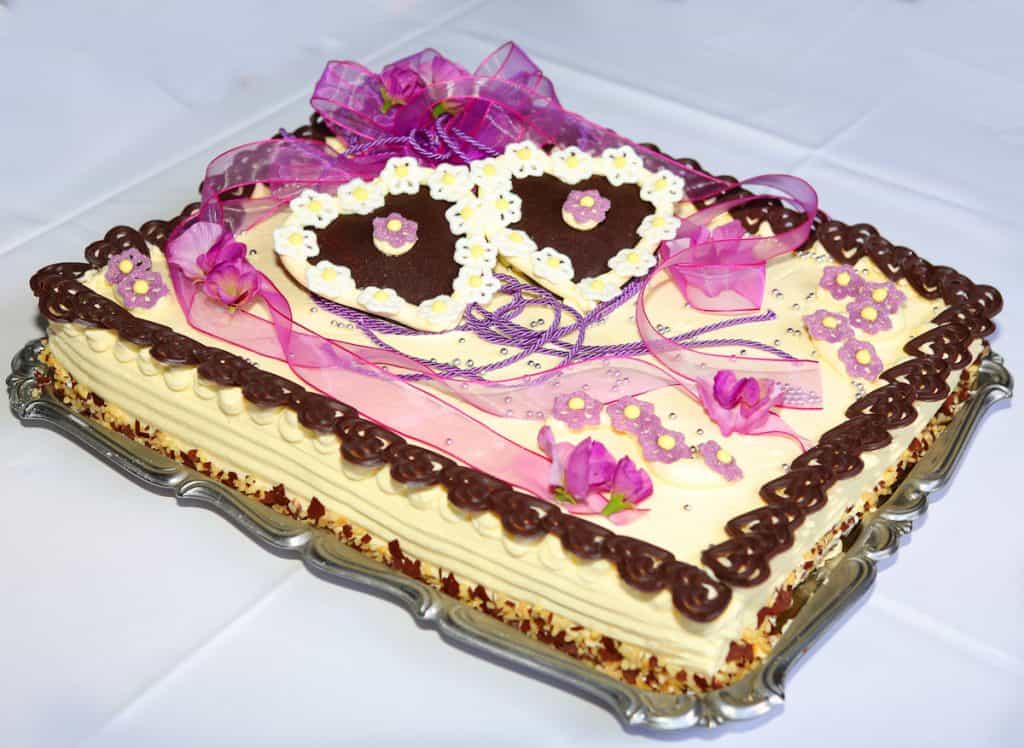
The most common German wedding cake is a type of sponge cake called a German Butter Cake. Often it is also filled with fruit.
The couple cuts the first slice of the wedding cake together. It is important to see whose hand is on top when cutting the cake. This shows who has the upper hand in the marriage later.
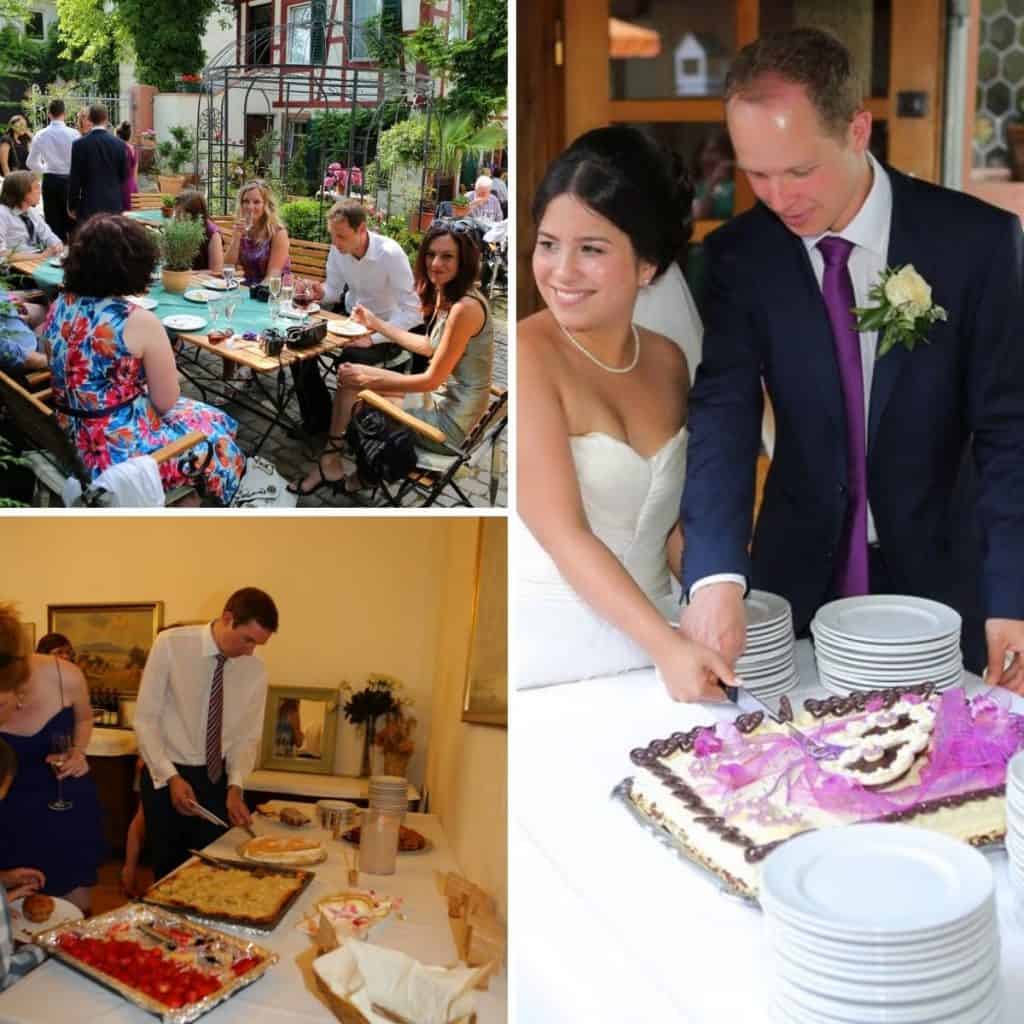
Another German tradition is that the groom feeds the bride the first piece of cake. This is supposed to symbolise that he cares for her.
Because I am obviously a foodie, I did not only have one cake, but my German friends donated some cake for the buffet.
So once we let the balloons rise in the air over the vineyards we all enjoyed a champagne reception followed by some “Kaffee und Kuchen” in the lovely vineyard courtyard.
DIY Wedding Seating Chart – with homemade Vodka shots
In the evening, the second part of our wedding celebration commenced. We asked all the guests to come into the great hall.
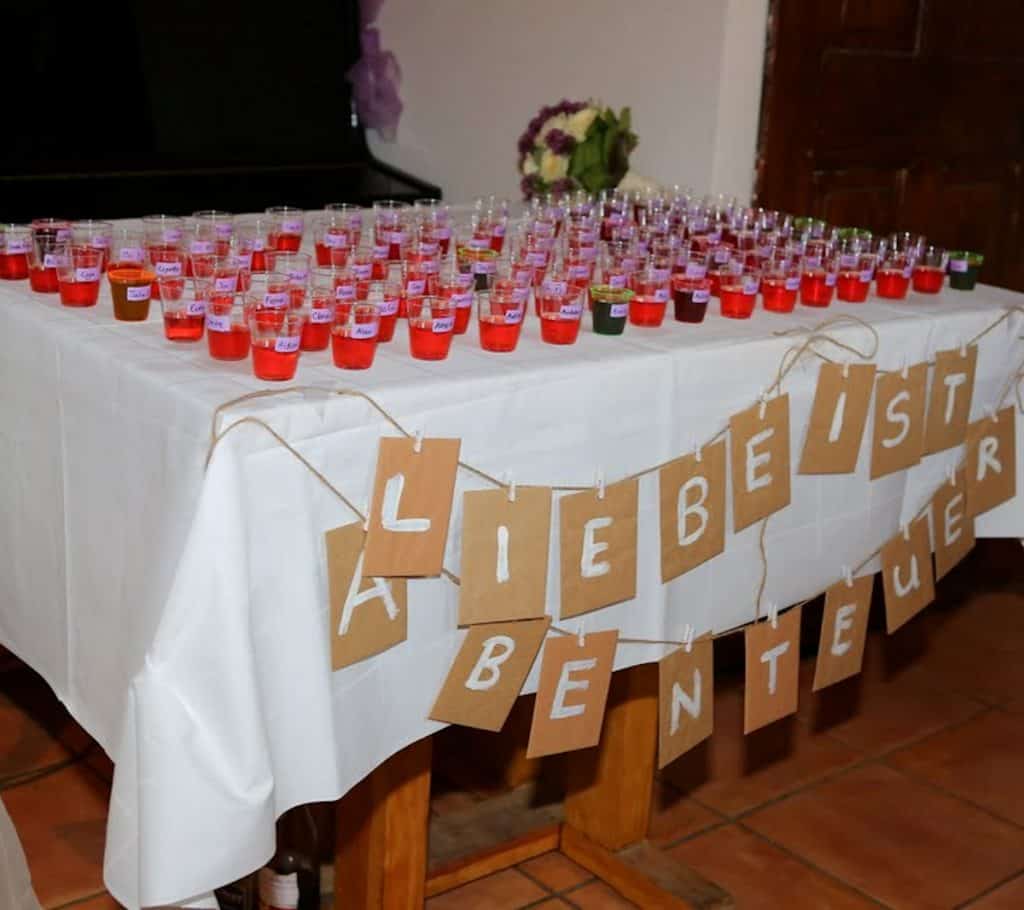
For the seating chart, we had a little different idea. Back in England, we prepared some homemade strawberry vodka. We wrote the guests' names on the side of the shot glasses. At the bottom of the shot glasses, we wrote the person’s table number. The guests had to take a shot before finding out where they were sitting.
Of course for the children, and those who did not want to drink alcohol, we had a fruit shot prepared.
You can get the recipe for the homemade strawberry vodka here.
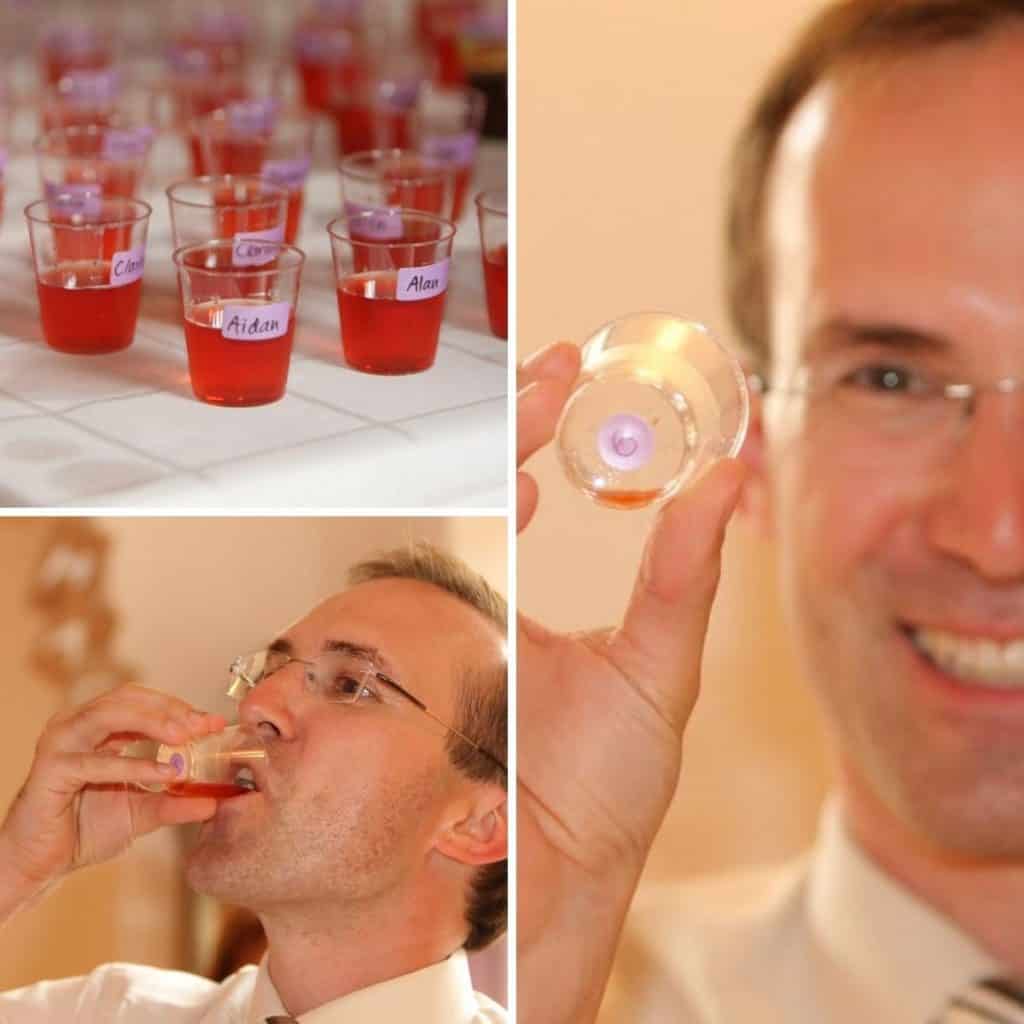
The wedding buffet – German wedding food
Is there such a thing as "typical German wedding food"? I tried hard to research the answer to this question. There is no such thing as a pan-German traditional wedding menu. The food at German weddings tends to be regional and plentiful. One highlight is the meat, which you will have a variety to choose from. Of course, nowadays you will also have vegetarian options.
Most of the German weddings I have been to did not have a three-course sit-down meal, as is usual in the UK, but a buffet.
Being a glutton by nature, I really preferred this option as it meant that you get to try lots of different dishes and would not be shy to ask for more.
Here is what was on the menu:
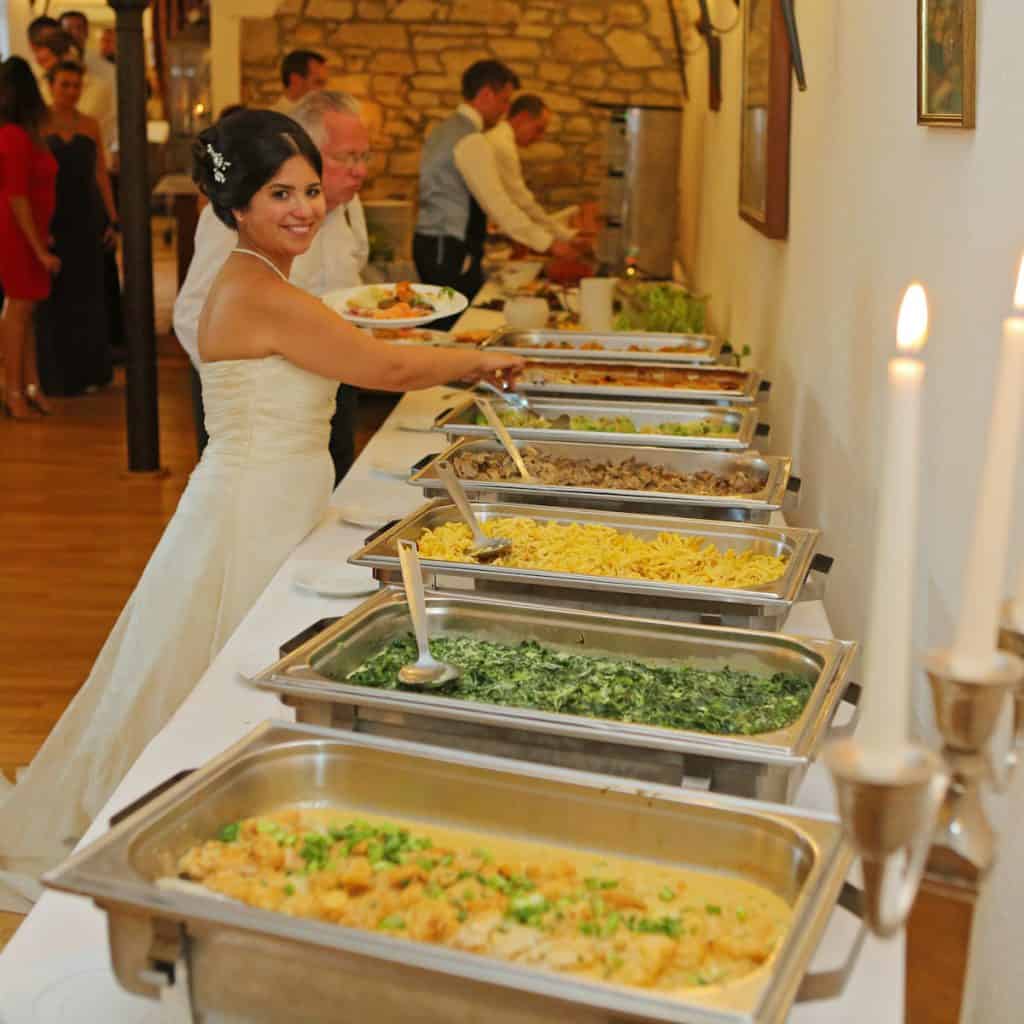
German wedding starters:
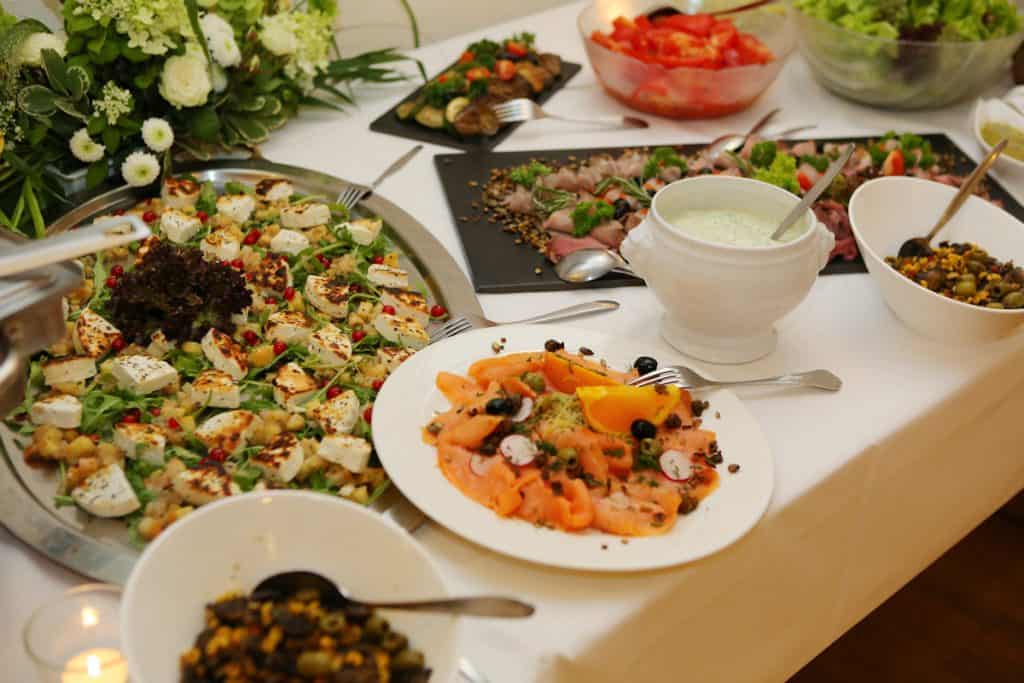
- Baked Goats Cheese with Thyme and Honey on a Pear and Rocket Salad
- Grilled Vegetable Platter of Aubergines, Courgettes, Peppers, Mushrooms and
mixed Olives with fresh Rosemary and Thyme - Pear Carpaccio and Tender Roast Beef with a Pepper Crust and
Traditional Herb Sauce of the Region - Mild Smoked Salmon with Raspberry Horseradish
- A Selection of Salads & Ciabatta
A selection of main courses
- Chicken Breast filled with Ricotta and Spinach with a Tomato and Herb Sauce
- Cape-Sea Pike Filet in Apple and Horseradish Sauce
- Beef Filet in a Chanterelle and Champignon Sauce
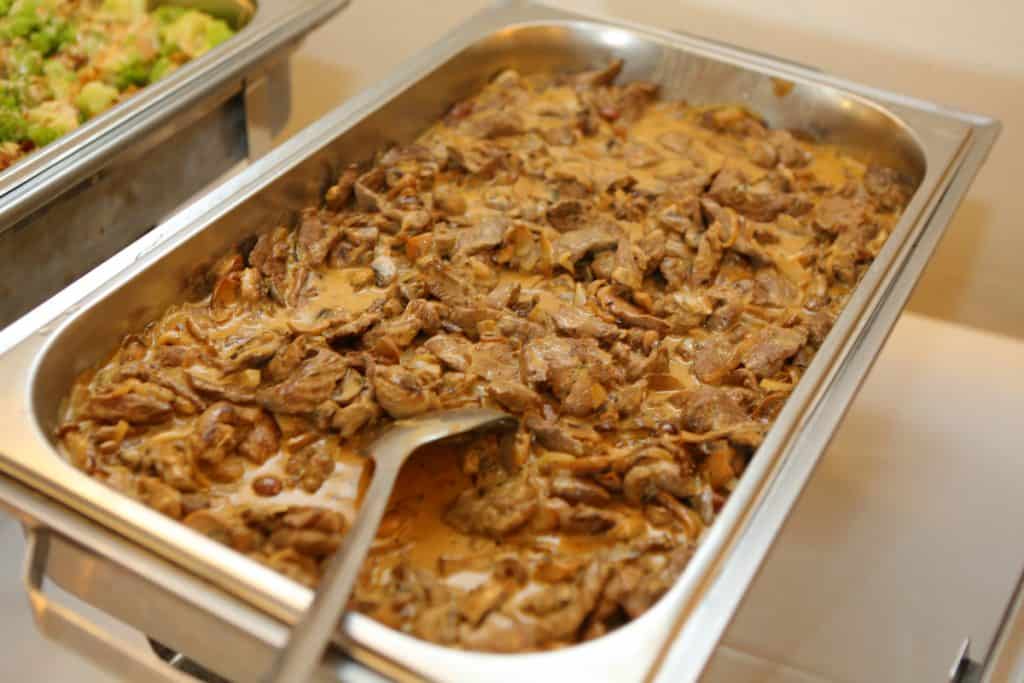
My Wedding Side Dishes
Turnip, Potato and Carrot Gratin with Béchamel Sauce
Knopfspätzle
Homemade Ratatouille and Romanesque-Vegetables, Spinach
Desserts
- Peach Mousse with Vanilla Sauce
- Cheese Board with Seasonal Fruits
- Chocolate and Baileys Mousse
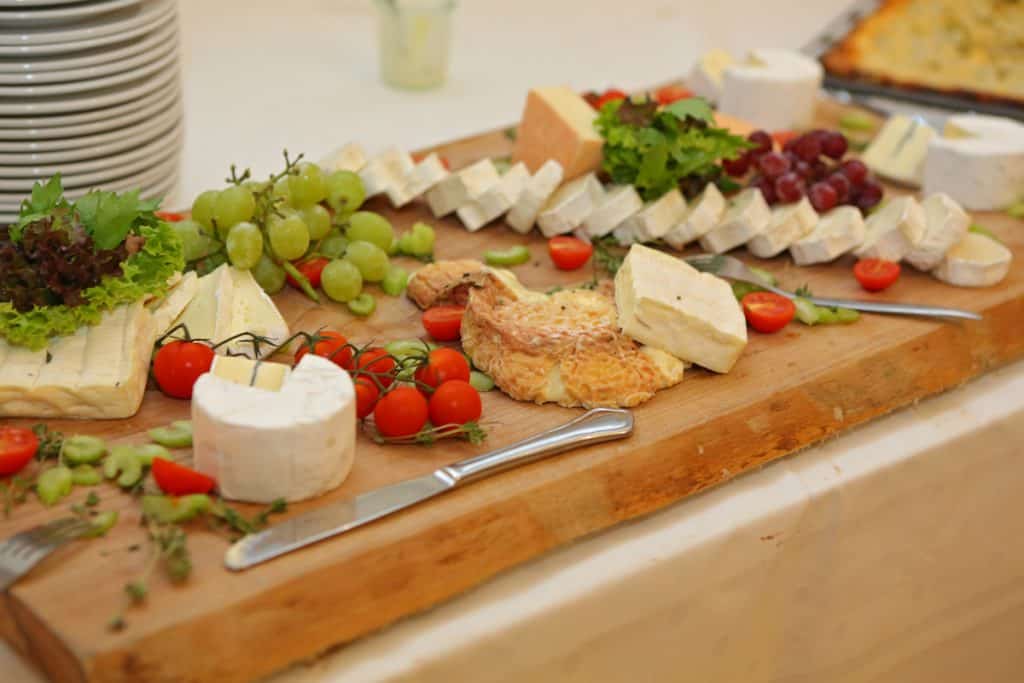
German Wedding Dance – the Viennese Waltz
In Germany the couple opens the dance floor with the first dance. This dance is traditionally a waltz. In German the dance is called “Brautwaltzer” (bride waltz), Hochzeitswaltzer (wedding waltz) or Brauttanz (bride dance). The waltz is traditionally a Viennese waltz and often the pieces of Johan Strauss are chosen. For example the Donau Waltzer or the Kaiser Waltzer.
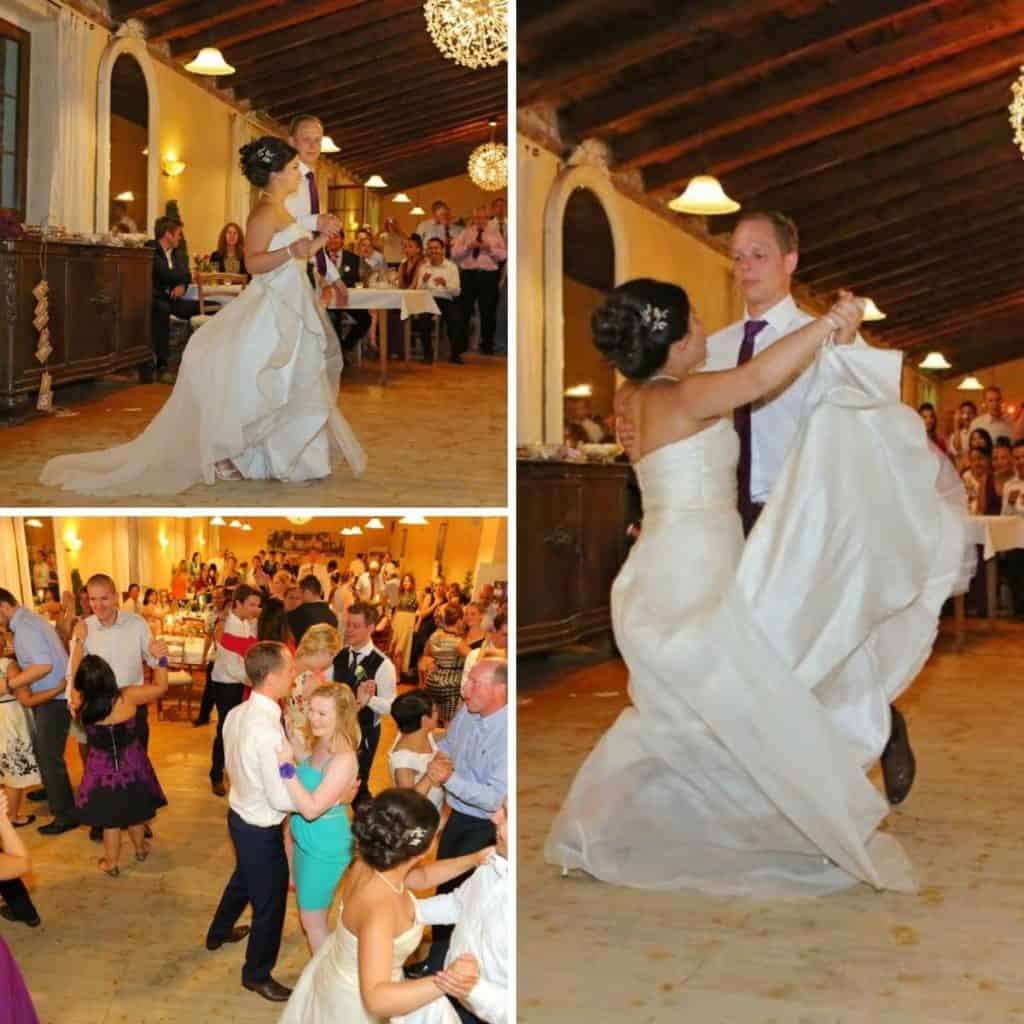
Dave and I chose Waltz No. 2 from Dmitri Shostakovich. I would lie if I said we danced it perfectly. A Viennese waltz is a very fast dance. We both are not the best dancers and my dress was restrictive (as you can see from the pictures).
We took some dancing lessons before the wedding, but in hindsight, I would have chosen a slow waltz.
The wedding dance has a similar symbolism to the wedding ring. It signifies that the wedding couple now is a unity, as the couple forms a ring as they turn around dancing.
However, don't worry if you are not a Ballroom dancer. Only the first dance is traditionally a waltz, the rest of the evening their will be more contemporary music.
The wedding bouquet
The wedding bouquet is another wedding custom that is now common in Germany but also around the world.
Traditionally the husband picks the wedding bouquet, as this is supposed to bring luck. (No chance I would let my husband pick mine - sorry!)
Here are some traditional flowers that you can often find in German Wedding Bouquets:
- Roses
- gypsophila
- Ivy
- myrtles
Another German wedding custom is to throw the bouquet to unmarried female guests. The lucky one who catches the bouquet is said to be next in line to get married.
How we turned our German wedding into a German Rave
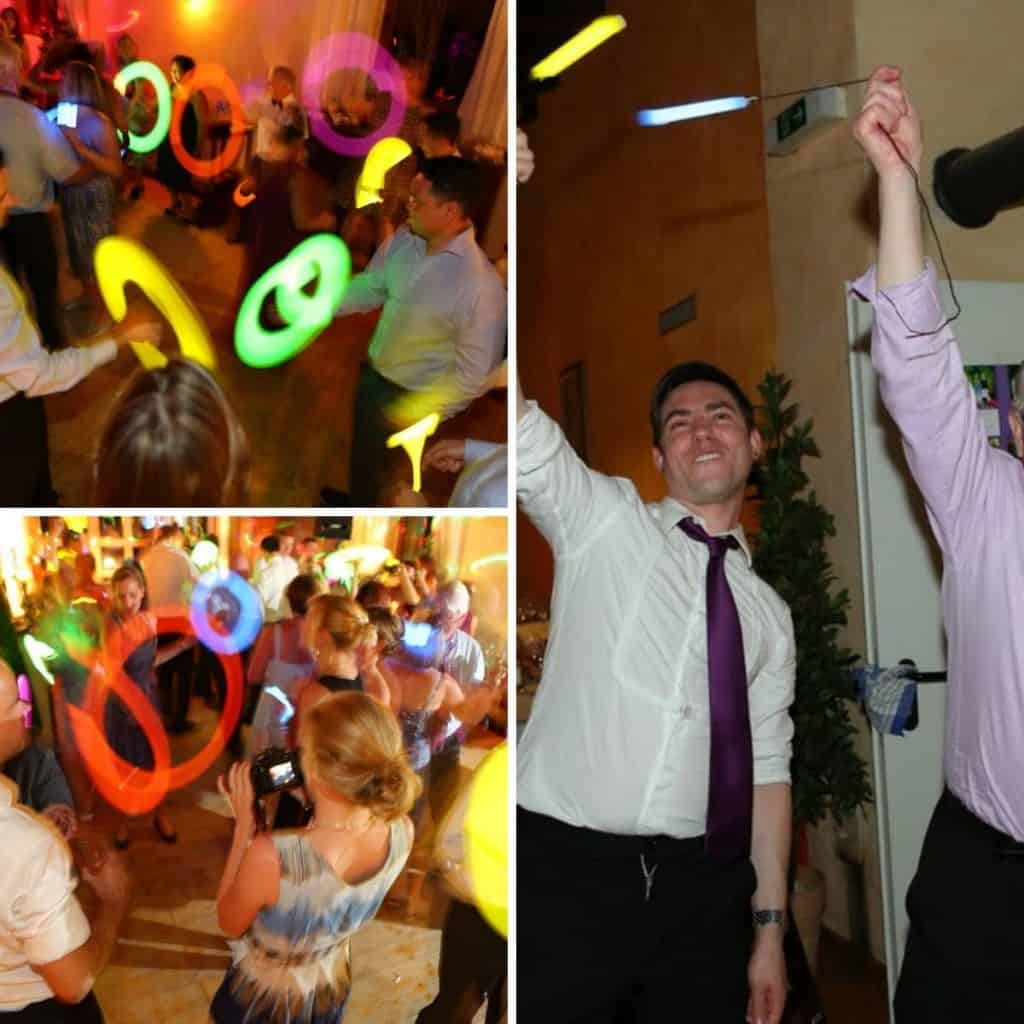
Apart from the wedding waltz, we did not have any music wishes. We created a web form, where our guests could add their favourite songs.
After the bouquet was thrown at 12 pm, we turned off the lights and every guest received a glow stick. This gave some energy, as the already tired guests partied on until 4 am.
German weddings go on for a long time. I have been at British weddings where carriages were called at 11 pm. This is almost unheard of in Germany, and you tend to party until early in the morning.
More German Wedding Traditons (which we did not use at our wedding)
These are German wedding games and activities that I have experienced, visiting German weddings but we did not use for our wedding.
Doves released at weddings
The dove represents love, fidelity and fertility. Often not only one dove is being released but a dove couple. Dove doubles, once they find one another stay together.
A loud wedding car with tins
If you are ever in Germany you pass a car which has tins/ cans tied to its bumper – then it is likely that the passengers just got married. This is to tell everybody who just got married. Often the car is accompanied by other beeping vehicles.


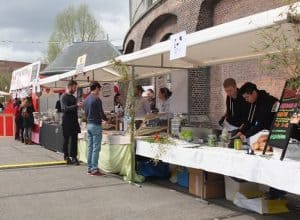



susan foster
This was really interesting, thanks for sharing
Marita
You are very welcome. I am glad you found it interesting.
Debbie
Have you heard of a traditional German wedding dessert called 'kokah' ? (not at all sure of the spelling) It is delicate and rich. A crust of flour/sugar/ butter/etc and filling of cream/sugar that has been cooked on stove, then all is baked. Had a 'sickerdoddle cookie' flavor. I would love to find a recipe.
Marita
Hi Debbie,
At the moment I am not sure which recipe you are referring to. I will have a lookout and ask my German friends and let you know if I come across it x